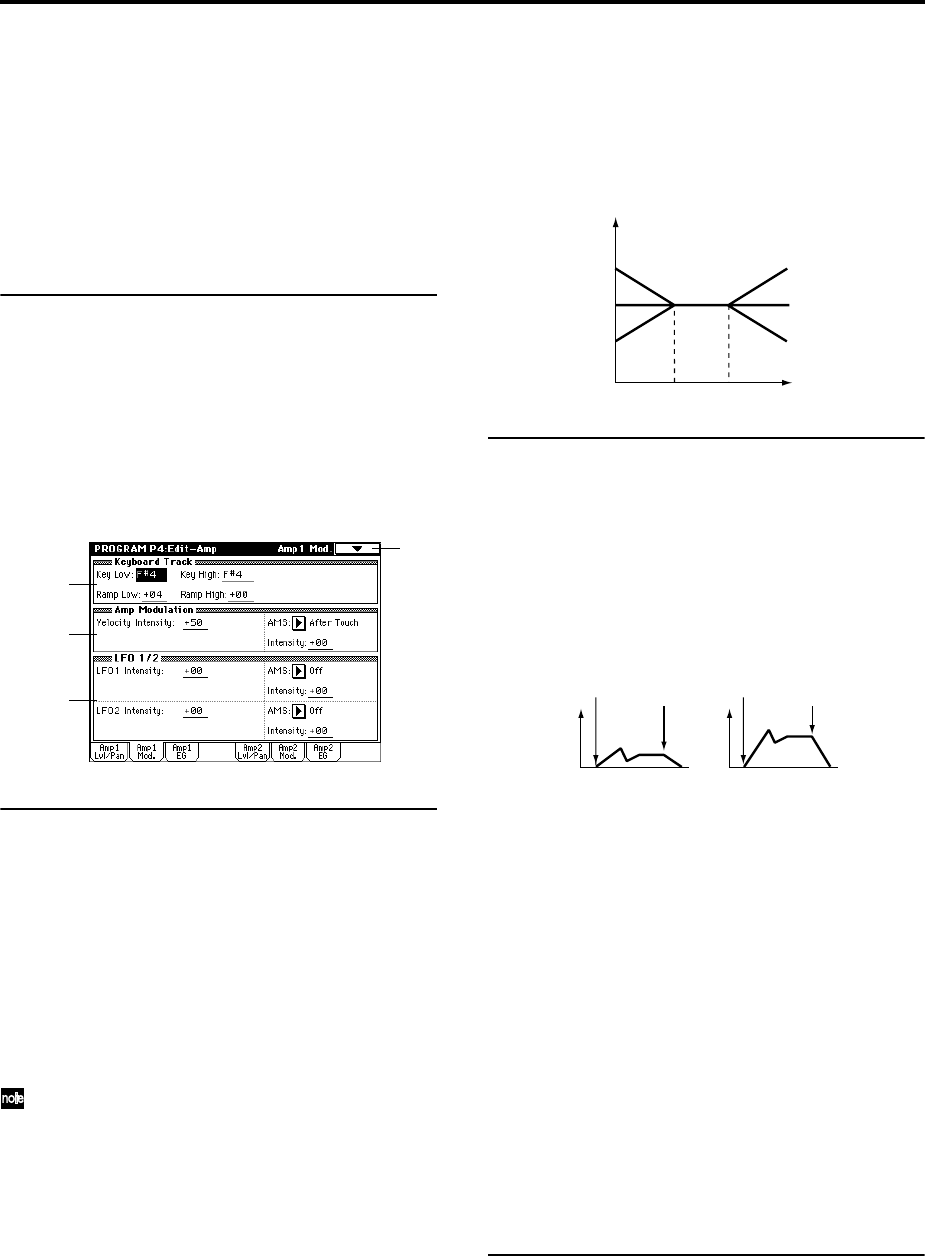
22
Intensity [–99…+99]
Specifies the depth of the effect produced by “AMS (Pan
AMS).”
For example if “Pan (Amp1 Pan)” is set to C064 and “AMS
(Pan AMS)” is Note Number, positive (+) values of this
parameter will cause the sound to move toward the right as
the note numbers increase beyond the C4 note (i.e., as you
play higher), and toward the left as the note numbers
decrease (i.e., as you play lower). Negative (–) values of this
parameter will have the opposite effect.
▼ 4–1: Page Menu Command
☞0–1A: Write Program, 1–1A: Copy Oscillator, 1–1B: Swap
Oscillator
4–2: Amp1 Mod.
Applies modulation to amp 1 (for oscillator 1), make settings
for keyboard tracking to vary the volume, and set the inten-
sity of velocity and LFO 1/2.
4–2a: Keyboard Track
These parameters let you use keyboard tracking to adjust
the volume of oscillator 1. Use the “Key Low,” “Key High”
and “Ramp Low, ” “Ramp High” parameters to specify how
the volume will be affected by the keyboard location that
you play.
Key:
Specifies the note number at which keyboard tracking will
begin to apply.
The volume will not change between “Key Low (KBDTrk
Key Low)” and “Key High (KBDTrk Key High).”
The note number can also be input by holding the
[ENTER] key and playing a note on the keyboard.
Key Low (KBDTrk Key Low) [C–1…G9]
Keyboard tracking will apply to the range of notes below the
note number you specify here.
Key High (KBDTrk Key High) [C–1…G9]
Keyboard tracking will apply to the range of notes above the
note number you specify here.
Ramp:
Specifies the angle of the keyboard tracking.
Ramp Low (KBDTrk Ramp Low) [–99…+99]
With positive (+) values of this parameter, the volume will
increase as you play notes below the “Key Low (KBDTrk
Key Low)” note number. With negative (–) values, the vol-
ume will decrease.
Ramp High (KBDTrk Ramp High) [–99…+99]
With positive (+) values of this parameter, the volume will
increase as you play notes above the “Key High (KBDTrk
Key High)” note number. With negative (–) values, the vol-
ume will decrease.
Volume change produced by keyboard location and Ramp settings
4–2b: Amp Modulation
These parameters specify how the volume of oscillator 1 will
be affected by velocity.
Velocity Intensity [–99…+99]
With positive (+) values, the volume will increase as you
play with more velocity.
With negative (–) values, the volume will decrease as you
play with more velocity.
AMS (Amp AMS) [Off, (PEG, FEG, EXT)]
Selects the source that will control the volume of amp 1
(“AMS List” ☞p.242). (EXT) Velocity cannot be selected.
Intensity (AMS Intensity) [–99…+99]
Specifies the depth and direction of the effect that “AMS
(Amp AMS)” will have.
The actual volume will be determined by multiplying the
value of the changes produced by the amp EG with the val-
ues of Alternate Modulation etc., and if the levels of the amp
EG are low, the modulation applied by Alternate Modula-
tion will also be less.
For example if “AMS (Amp AMS)” is set to After Touch,
positive (+) values of this parameter will cause the volume
to increase when pressure is applied to the keyboard. How-
ever if the EG settings etc. have already raised the volume to
its maximum level, the volume cannot be increased further.
With negative (–) values of this parameter, the volume will
decrease when pressure is applied to the keyboard.
4–2c: LFO 1/2
These parameters let you use “OSC1 LFO1” (5–1) and
“OSC1 LFO 2” (5–2) to control the oscillator 1 volume.
LFO1 Intensity [–99…+99]
Specifies the depth and direction of the effect that “OSC1
LFO1” will have on the volume of oscillator 1. Negative (–)
values will invert the LFO waveform.
4–2
4–2a
4–2b
4–2c
Volume
Key
Ramp Low=+99
Ramp Low=0
Ramp Low=–99
Ramp High=+99
Ramp High=0
Ramp High=–99
Key Low
Key High
Volume change (with positive (+) values of this parameter)
Softly played
Strongly played
Note-on
Note-off
Note-on
Note-off


















